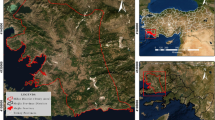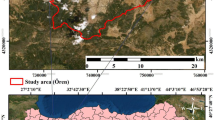Abstract
Wild forest fires are one of the greatest environmental disasters affecting forest resources. Along the coastal zone of the Mediterranean region in Turkey, forested areas are classified as first-degree, fire-sensitive areas. Every year, thousands of hectares of forests have been destroyed in Turkey. In this study, fire-access zones were determined in the Mediterranean forests of Turkey, by utilizing geographic information systems (GIS) technology. The effective reach distance of fire hoses from both sides of roads was considered in order to delineate fire-access zones. The effective reach distance can vary based on the technical capabilities and hydraulic capacity of fire trucks (minimum and maximum pressures on water pump); terrain structures (uphill, downhill and flat); and ground slope. These factors and their influences were studied in fire sensitive forest areas located in the eastern Mediterranean city of Kahramanmaraş in Turkey. First, terrain structures on both sides of the road network and ground-slope classes were determined based on GIS data layers. Then, fire access zones were delineated according to water pressure data, terrain structures, and ground-slope classes. The results indicated that 69.30 % of the forested areas were within the fire-access zones, while the rest of the forest was out of reach the fire hoses. The accessible areas were also calculated for forested areas with different fire-sensitivity degrees. The accessible areas were 69.59, 69.96, and 67.16 % for the forested areas that are sensitive to fires at the first, second, and third degrees, respectively. This finding has implications for the monitoring and management of fire threats in areas outside of the reach distance. The outside areas should receive extra attention and monitoring during the fire season so that fires are detected ahead of time and management has sufficient time to react. Besides, new roads should be considered for these areas in order to access more lands in a shorter amount of time.





Similar content being viewed by others
References
Acuna MA, Palma CD, Cui W, Martell DL, Weintraub A (2010) Integrated spatial fire and forest management planning. Can J For Res 40(12):2370–2383
Akay AE, Erdas O, Reis M, Yuksel A (2008) Estimating sediment yield from a forest road network by using a sediment prediction model and GIS techniques. Build Environ 43(5):687–695
Akay AE, Sivrikaya F, Sakar D. 2010. Evaluating the efficiency of fire helicopter located in Arsuz-Antakya in fire fighting activities. The 1st International Turkey & Japan Environment and Forestry Symposium. 02-05 November, Trabzon, Turkey
Akay AE, Wing GM, Sivrikaya F, Sakar D (2012) A GIS-based decision support system for determining the shortest and safest route to forest fires: a case study in Mediterranean Region of Turkey. Environ Monit Assess 184(3):1391–1407
Akbulak C, Özdemir M. 2008. The Application of the visibility analysis for fire observation towers in the Gelibolu Peninsula (NW Turkey) Using GIS. BALWOIS 27-31 May, Ohrid, Republic of Macedonia. 7 p
Böhmer M, Dvorscak P. 2006. Evaluation and optimization of fire control forest accessing for classic fire-fighting attack. Proceedings of the 2nd International Scientific Conference-Fire Engineering. Lucenec, 35-44
Demir M, Kucukosmanoglu A, Hasdemir M, Ozturk T, Acar HH (2009) Assessment of forest roads and firebreaks in Turkey. Afr J Biotechnol 8(18):4553–4561
Dindaroğlu T, Reis M, Akay AE, Tonguç F (2014) Hydroecological approach for determining the width of riparian buffer zones for providing soil conservation and water quality. Int J Environ Sci Technol 12(1):275–284
Drosos VC, Giannoulas VJ, Stergiadou A, Karagiannis E, Doukas KG. 2014a. Protection against fire in the mountainous forests of Greece case study: forest complex of W. Nestos. Second International Conference on Remote Sensing and Geoinformation of the Environment (RSCy2014), 07-10 April, Paphos, Southern Cyprus
Drosos VC, Giannoulas VJ, Stergiadou A, Daoutis C. 2014b. Forest construction infrastructures for the prevision, suppression, and protection before and after forest fires. Second International Conference on Remote Sensing and Geoinformation of the Environment (RSCy2014), 07-10 April, Paphos, Southern Cyprus
Durmaz BD, Bilgili E, Kucuk O, Kadıogulları A, Baskent EZ, Saglam B (2006) Spatial fire potential analysis and mapping using landsat satellite imagery and GIS. For Ecol Manage 234S:18–38
Gumusay MU, Sahin K (2009) Visualization of forest fires interactively on the internet. Scien Res and Essay 4(11):1163–1174
Kucuk O, Bilgili E (2006) The conveyance of fire behavior characteristics into practice by using Geographical Information Systems (GIS): a case study in Kastamonu. Gazi Univ Facul For J 6(2):262–273
Kucuk O, Unal S (2005) Determination of fire sensitivity degree: a case study in Tasköprü State For Enterp. Kafkas Univ Facul For J 6(1–2):28–34
Majlingova A (2012) Opening-up of forests for fire extinguishing purposes. Croatian J For Eng 33(1):159–168
Oğuz H, Akay AE, Taylan H, Yenilmez N. 2011. Using Land Surface Temperature to Evaluate Forest Fire Risk. VI. International Symposium on Ecology and Environmental Problems, 17-20 November, Antalya, Turkey
Sağlam B, Bilgili E, Durmaz BD, Küçük Ö, Kadıoğulları Aİ (2008) Spatio-temporal analysis of forest fire risk and danger using LANDSAT imagery. Sensors 8:3970–3987
Sivrikaya F, Keles S, Cakir G (2007) Spatial distribution and temporal change of carbon storage in timber biomass of two different forest management units. Environ Monit Assess 132:429–438
Sivrikaya F, Akay AE, Oguz H, Yenilmez N. 2011. Mapping forest fire risk zones using GIS and remote sensing technologies. VI. International Symposium on Ecology and Environmental Problems, 17-20 November, Antalya, Turkey
Sivrikaya F, Sağlam B, Akay AE, Bozali N (2014) Evaluations of forest fire risk with GIS. Polish J Environ Studies 23(1):187–194
Stergiadou A (2014) Prevention and suppression of forest-fires by using the road network and water tanks. Fresenius Environ Bull 23(11):2755–2761
Wilkie ML, Holmgren P, Castaneda F (2003) Sustainable forest management and the ecosystem approach: two concepts, one goal. For Depart, FAO
Wing MG, Eklund A, Sessions J (2010) Applying LiDAR technology for tree measurements in burned landscapes. Internat J Wildland Fire 19:104–114
Yakubu I, Mireku-Gyimah D, Duker AA (2015) Review of methods for modelling forest fire risk and hazard. Afri J Environ Sci Technol. 9(3):155–165
Yucel M (1998) Computing fire sensitivity of forest regions. The J For Eng 7:22–25
Yuksel A, Akay AE, Gundogan R (2008) Using ASTER imagery in land use/cover classification of eastern mediterranean landscapes according to CORINE land cover project. Sensors 8:1237–1251
Author information
Authors and Affiliations
Corresponding author
Additional information
Project funding
This work was supported by The Scientific and Technological Research Council of Turkey (TUBITAK, Grant number: 110O928).
The online version is available at http://www.springerlink.com
Corresponding editor: Hu Yanbo
Rights and permissions
About this article
Cite this article
Akay, A.E., Wing, M.G., Zengin, M. et al. Determination of fire-access zones along road networks in fire-sensitive forests. J. For. Res. 28, 557–564 (2017). https://doi.org/10.1007/s11676-016-0283-5
Received:
Accepted:
Published:
Issue Date:
DOI: https://doi.org/10.1007/s11676-016-0283-5




